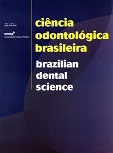Efeito de dois sistemas de polimento mecânico na rugosidade superficial da cerâmica feldspática
DOI:
https://doi.org/10.14295/bds.2010.v13i1/2.14Abstract
RESUMO
Em determinadas situações clínicas faz-se necessário o polimento mecânico das superfícies de restaurações em cerâmica após sua cimentação. O objetivo desse estudo foi avaliar quantitativamente e qualitativamente a rugosidade superficial de quatro cerâmicas feldspáticas quando submetidas ao polimento mecânico com dois diferentes sistemas após simulação de ajuste oclusal. Foram confeccionados 48 discos de cerâmica feldspática, sendo 12 discos da cerâmica Super Porcelain EX-3 (Noritake), 12 discos Ceramco 3 (Dentsply), 12 discos Duceram Plus (Ducera) e 12 discos Heraceram (Heraeus Kulzer). Todas as amostras foram glazeadas e posteriormente 10 discos de cada cerâmica receberam desgaste com ponta diamantada 4138 para simular ajuste oclusal, seguido das pontas diamantadas 4138F e 4138FF. Posteriormente, metade de cada disco foi polida com o sistema para polimento da Edenta e, a outra metade, com o sistema para polimento da Komet. Dois discos de cada cerâmica permaneceram glazeados (grupo controle). Para realizar a análise quantitativa, a média de rugosidade superficial das amostras foi medida, antes e depois do polimento das superfícies, utilizando o rugosímetro SL-201 (Mitutoyo). A análise qualitativa foi realizada com microscópio eletrônico de varredura. Os dados de rugosidade superficial foram submetidos ao teste t-student pareado (a=0,05). As superfícies polidas com os sistemas Edenta e Komet não reproduziram a lisura superficial das superfícies glazeadas. Entretanto, o sistema Edenta proporcionou menor rugosidade superficial nas cerâmicas testadas em relação ao sistema da Komet.
Downloads
Downloads
Published
How to Cite
Issue
Section
License
Brazilian Dental Science uses the Creative Commons (CC-BY 4.0) license, thus preserving the integrity of articles in an open access environment. The journal allows the author to retain publishing rights without restrictions.
=================




























